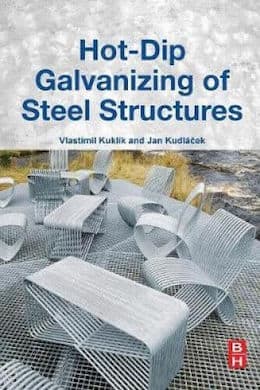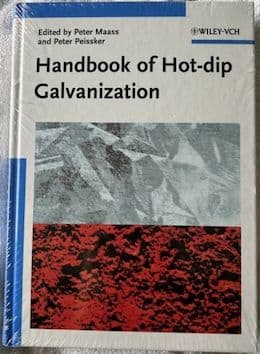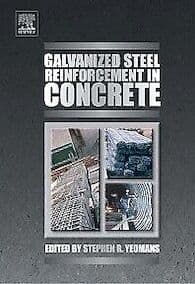
-----
How to make Galvanizing Flux?
Q. We are into Manufacturing of Zinc Chloride solution and want to diversify and enter into flux manufacturing.
We want to know surfactants used in preflux and blanket flux for hot dip galvanising process.
- Mumbai Maharashtra
May 28, 2022
A. Hi Abhijit. Geoff Crowley tells us that dishwashing liquid is one possibility. Dr. Thomas Cook suggests what he feels is a good surfactant in our on-line library. Readers are encouraged to suggest published articles or books! And there is probably also some good information in patents.google.com, and maybe scholar.google.com
Unfortunately we cannot encourage spam, nor possibly participate in blowing trade secrets, by going into proprietary info.
Luck & Regards,

Ted Mooney, P.E. RET
Striving to live Aloha
finishing.com - Pine Beach, New Jersey
Ted is available for instant help
or longer-term assistance.
![]() Thank you very much sir.
Thank you very much sir.
- Mumbai, India
⇩ Related postings, oldest first ⇩
for Engineers, Shops, Specifiers

avail from eBay, AbeBooks, or Amazon

avail from eBay, AbeBooks, or Amazon

avail from eBay, AbeBooks, or Amazon

avail from eBay, AbeBooks, or Amazon
avail from Amazon
"User's Guide to Hot Dip Galvanizing for Corrosion Protection in Atmospheric Service" by NACE (1997 only rarely avail.)
avail from AbeBooks, or Amazon
(as an Amazon Associate & eBay Partner, we earn from qualifying purchases)
Q. Dear Sir,
We are a manufacturer of Zinc Chloride powder. We have received several inquiries from the galvanizing industry for Galvanizing flux. But we don't know the procedure of how to prepare double salts and triple salts. We know the combination of Zinc Chloride and Ammonium Chloride but there is one more additives which has to be added in the mixture that we don't know. How to make that additive and how much quantity do we have to add?
M/s. ASHOK CHEMICAL INDUSTRY - Mumbai, Maharastra & India
October 25, 2008
A. Sir:
The proper wetting agent is the proper third ingredient and at about 0.03% to 0.06% to act as:
(1) Steel corrosion inhibitor;
(2) Surfactant to evenly spread the flux solution and to reduce the surface tension from about 80 dynes/cm2 to about 30 dynes/cm2, and
(3) A suds (bubbles) former to have (along with a very small air source) on the flux surface to reduce energy costs by about 50% for the flux solution.
Galvanizing Consultant - Hot Springs, South Dakota, USA
Q. Thank you very much for your valuable suggestion. Sir can you advise me the proper name of Wetting agent (surfactant) name for use in all type of galvanizing industry, such as pipe galvanizing, sheet galvanizing and high transmission tower galvanizing.
Awaiting for your valuable reply.
With Best Regards,
- Mumbai, India
October 14, 2011
A. Hi Vijay.
If you cannot find this info on this site already with our search engine, nor in any of the many books about galvanizing, please search the patent literature for info on galvanizing fluxes.
We can't print the names of commercial products or we would be a spam magnet, and we must be careful as well about posting info from people not well known to us which might blow trade secrets. Good luck.
Regards,

Ted Mooney, P.E.
Striving to live Aloha
finishing.com - Pine Beach, New Jersey
Ted is available for instant help
or longer-term assistance.
Multiple threads merged: please forgive chronology errors and repetition 🙂
Chemical name or trade name of wetting agent used in Flux
Q. Please provide me the generic (chemical) name or trade name of the wetting agent (surfactant) used in the Flux along with supplier info.
Please further advise me about benefits of alloying by addition in Hot Dip Galvanising of Aluminium (Al) and or Rare Earth Metals Lanthanum / Cerium.
Regards,
Trainee in Development of Fluxes - Hyderabad, A.P. & India
January 18, 2011
Fairy Liquid.
It's a household detergent in the UK that's used for a number of uses, such as flux wetting agent, cement plasticiser, and others. Not sure if it's any good for washing dishes though!

Geoff Crowley
Crithwood Ltd.
Westfield, Scotland, UK

Fluxing in pure zinc chloride?
Q. Bit of a speculative question:
Most galvanizers use a flux containing a mixture of ammonium chloride and zinc chloride. The proportions of these vary. I've heard of 1.5:1 to 4:1 (ammonium to zinc chlorides).
The most commonly used seems to be (in Europe) 2:1, some use 3:1.
But what about using only zinc chloride. Why would that not work?
It would certainly produce less fume, but maybe by lacking in ammonia
⇦ on
eBay or
Amazon [affil link] it would fail to produce an acidic environment at the point of sublimation, during immersion of the steel into the zinc?
Thoughts?

Geoff Crowley
Crithwood Ltd.
Westfield, Scotland, UK

April 26, 2017
A. Hello Geoff,
I don't have so much experience in flux formulations, but ammonia has a major function in the process. As the pickled steel immerses in the flux, zinc chloride can't protect the surface from rust, but ammonium and ammonia are in equilibrium in the solution and this pair can react with the steel in the surface to prevent it from rusting.
Itself, the ammonium/ammonia pair have good affinity for iron, as it is aded in some formulations to take iron out from the reaction (I can think now in some hexavalent chromates, for example).
I don't think ammonium chloride can't be replaced, I think it is more complicated than using only zinc chloride. I think you could use anything that has affinity for iron and can protect it from rust through the process.
Regards!!
TEL - N FERRARIS - Cañuelas, Buenos Aires, Argentina
Q. Greetings and Salutations,
We have a Galvanizing Unit in our factory and we want to make the flux bath new. I am talking about we are going to empty/fill the bath. We purchase the flux as powder. My question is:
- What is the mixture of powder flux and water
- Do I need to pay attention for another issue.
Thanks for helping. I am looking forward to hearing from you.
- Ankara, Turkey
January 10, 2018
A. Sir:
What type solid flux (mono, double, triple, or quadra) is the solid powder? Or if you can find it out, what is the ACN? Or what is the % ammonium chloride and % zinc chloride?
What is the TDS (total dissolved solids) in your tap water?
What density (or Baumé) do you want in the flux solution?
From what country did you buy your flux?
Only from answers to the above question can the results be calculated.
Regards,
Galvanizing Consultant - Hot Springs, South Dakota USA
Q. Sir, I am dipen from India and I want to prepare galvanizing flux but I don't know the exact components and their compositions. Please tell the ingredients and their quantities.
Dipen AggarwalDinesh Trading Company, Hisar Haryana - Hisar, Haryana, India
February 10, 2019
Q. Are there any additives good for fluxing solution to increase efficiency and reduce consumption of molten zinc?
I read above that wetting agent is good but what kind of surfactant can be used?
Metal treatment chemicals - KSA RIYADH
A. Hi cousin Dipen. Hi cousin Anwar. If you are looking to formulate your own flux, please try scholar.google.com; it seems to offer lots of excellent papers!
Sorry but we can't offer non-published formulation info except vetted responses from people well known to us because responses from people we don't know might contain trade secret info :-(
Regards,

Ted Mooney, P.E. RET
Striving to live Aloha
finishing.com - Pine Beach, New Jersey
Ted is available for instant help
or longer-term assistance.
Comment: Hi Ted Mooney
I didn't ask for formula I asked about type of wetting agent can be used. I can make my own formula; if anyone has an answer I appreciate his help.
Thank you
Suggest metal treatment chemicals - KSA Riyadh
A. Hi again Anwar. Please try the source I suggested for published info; there seem to be dozens of papers on the general subject. If anyone can refer you to additional published info, we'll certainly post the reference. And if anyone well known to us suggests what wetting agent to use we will post it.
Regards,

Ted Mooney, P.E. RET
Striving to live Aloha
finishing.com - Pine Beach, New Jersey
Ted is available for instant help
or longer-term assistance.
![]() Hi Ted Mooney. Thank you for your kind response.
Hi Ted Mooney. Thank you for your kind response.
Metal treatment chemicals - KSA RIYADH
A. There is a simple answer, not very scientific, but has been used effectively on occasions by some. That is domestic dishwashing liquid. Added to the flux it forms an effective surfactant.

Geoff Crowley
Crithwood Ltd.
Westfield, Scotland, UK

Ed. note: Thanks Geoff!
Q. Dear Friends, is galvanizing fumes and air pollution being influenced by flux?
I mean is it possible to decrease fume and pollution by changing the flux additives or temp, etc.?
Thank you.

Amin Baba
Pars Galvanize AMIN - Istanbul, Turkey
July 29, 2019
A. There are many UK and European galvanizers using a so called "low fuming flux".
Most fluxes contain ammonium chloride and zinc chloride in various proportions. The ammonium chloride is the bit that produces the fumes, and it might be supposed that decreasing this proportion of the flux would reduce the fume, and it does do that, but other side effects can sometimes be noticed.
We have used fluxes from 1:1 molecular ratio of these two components to 3.5:1 ratio. The biggest observable differences are...
Low ammonium chloride ratio means less fume, but more splash as the flux doesn't dry so well. Splash costs zinc.
High ratio ammonium chloride means more fume but less splash.
Fume production can be collected and filtered.
Zinc losses are not easily reclaimed.

Geoff Crowley
Crithwood Ltd.
Westfield, Scotland, UK

Q, A, or Comment on THIS thread -or- Start a NEW Thread
